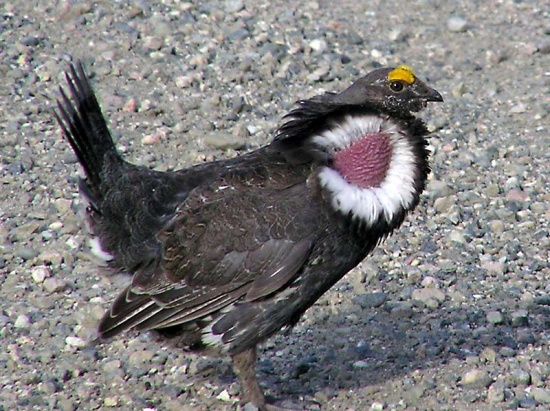m (add to description) |
(add information) |
||
| Line 8: | Line 8: | ||
==Distribution== | ==Distribution== | ||
| − | [[ | + | Western [[Canada]] and western states of the [[USA]] in mountainous regions. |
==Taxonomy== | ==Taxonomy== | ||
| − | + | In 2006 the American Ornithological Union split this species into '''Dusky Grouse''' ''D. obscurus'' of the Rockies and '''Sooty Grouse''' ''D. fuliginosus'' of the Pacific Coast.<sup>[[#References|[1]]]</sup> | |
| + | |||
[[Image: Blue_grouse_010_female.jpg|thumb|350px|right|Photo by Dave B Smith<br />female (Dusky)<br />Location: Sheep River PP, Alberta, [[Canada]]]] | [[Image: Blue_grouse_010_female.jpg|thumb|350px|right|Photo by Dave B Smith<br />female (Dusky)<br />Location: Sheep River PP, Alberta, [[Canada]]]] | ||
==Habitat== | ==Habitat== | ||
| − | Conifer and mixed forests, shrub, desert, tundra, | + | Conifer and mixed forests, shrub, desert, tundra, up to 3,600m. Not found in arid regions or plains. |
| + | |||
==Behaviour== | ==Behaviour== | ||
| − | They nest in a ground scrape. | + | The male inflates its colorful air sac during courtship to produce owl-like hoots that can be heard at considerable distance. They nest in a ground scrape. Incubation is 25-26 days by the female. Nonmigratory, but they move in elevation with the seasons, spending the summers in mixed deciduous forests and winter in conifers at higher elevations. Relatively tame, they often allow close approach before walking or running into thickets. |
| + | |||
| + | Diet: Includes berries, tree buds, twigs, leaves, seed, and insects. In winter the diet includes conifer needles. | ||
| − | |||
==References== | ==References== | ||
| − | [http://www.aou.org/checklist/suppl/AOU_checklist_suppl_47.pdf 47th Supplement to the AOU Checklist] | + | #[http://www.aou.org/checklist/suppl/AOU_checklist_suppl_47.pdf 47th Supplement to the AOU Checklist] |
==External Links== | ==External Links== | ||
Revision as of 02:55, 12 October 2009
- Dendragapus obscurus
Identification
42cm. Mottled brown, chicken-like birds with a dark tail.
Males: have a yellow comb above the eye that can be raised during displays, and black-tipped white feathers on the neck that cover reddish patches of bare skin, which are inflatable during displays. Grey band on tail
Females: are mottled brown above and mottled gray below. Brown tail with grey band.
Northern populations of Dusky Grouse (Nevada-Idaho border north) lack the blue-gray tail band seen in Sooty Grouse, but Dusky Grouse in the southern part of the species range (Nevada, Utah, southward) do have the tail band.
Distribution
Western Canada and western states of the USA in mountainous regions.
Taxonomy
In 2006 the American Ornithological Union split this species into Dusky Grouse D. obscurus of the Rockies and Sooty Grouse D. fuliginosus of the Pacific Coast.[1]
Habitat
Conifer and mixed forests, shrub, desert, tundra, up to 3,600m. Not found in arid regions or plains.
Behaviour
The male inflates its colorful air sac during courtship to produce owl-like hoots that can be heard at considerable distance. They nest in a ground scrape. Incubation is 25-26 days by the female. Nonmigratory, but they move in elevation with the seasons, spending the summers in mixed deciduous forests and winter in conifers at higher elevations. Relatively tame, they often allow close approach before walking or running into thickets.
Diet: Includes berries, tree buds, twigs, leaves, seed, and insects. In winter the diet includes conifer needles.





